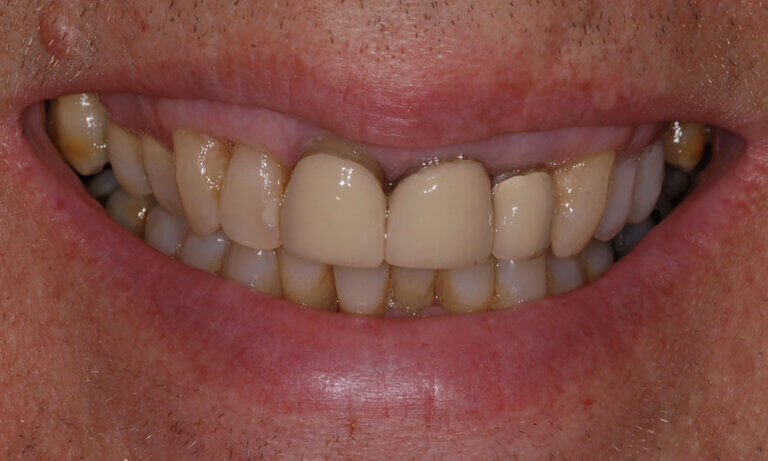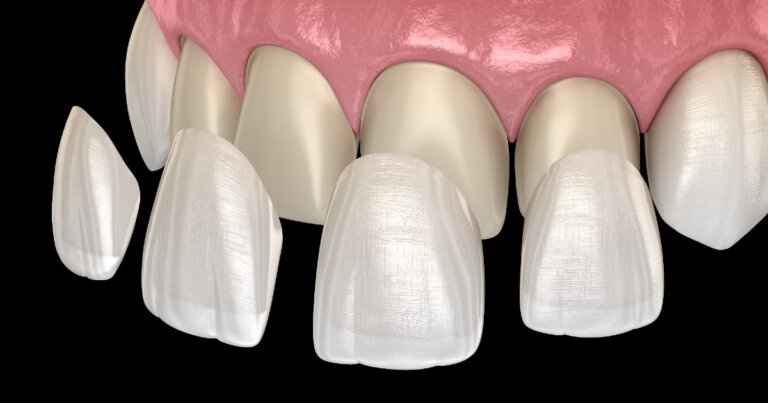Dental Veneer Open Margin

What Is A Dental Veneer Open Margin?
A dental veneer is a thin, custom-made shell placed on the front surface of a tooth to enhance its appearance. These veneers, crafted from porcelain or composite resin, closely mimic the color, shape, and texture of natural teeth. An essential factor in veneer success is achieving a smooth, continuous surface from the veneer to the natural tooth. This prevents bacteria and food from becoming trapped along the margin, which can lead to what’s known as a “Dental Veneer Open Margin.” This open margin occurs when the veneer doesn’t fit tightly against the tooth, leaving a small gap. Open margins can be due to various factors, including improper bonding or poor initial design. If not promptly addressed, an open margin can lead to serious oral health issues such as tooth decay, gum disease, pain, and even tooth loss.
Before you contact a Toronto dentist to examine a Dental Veneer Open Margin, there are some things you should know as a patient:
- Causes of Dental Veneer Open Margins
- Signs And Symptoms Of A Dental Veneer Open Margin
- Treatment Options For A Dental Veneer Open Margin
- Managing A Dental Veneer Open Margin Until You Can See The Dentist
- Frequently Asked Questions About Dental Veneer Open Margins
If you have questions about a Dental Veneer Open Margin or other dental problems, please contact us for more information.
Causes of Dental Veneer Open Margins
Open margins in dental veneers can happen for several reasons, including:
Improper Veneer Design: The dental lab must ensure that the margin of the veneer aligns perfectly with the tooth’s preparation. This seamless connection helps prevent gaps that can trap bacteria. Errors can occur if outdated physical impressions are used instead of digital scans, or if factors like blood or moisture interfere with the impression process.
Poor Veneer Placement: Precise veneer placement is essential. During bonding, the veneer must sit flush with the tooth surface. Even slight misalignment or elevation can leave a gap, resulting in an open margin. This is why proper cementation is crucial.
If you’re experiencing an open margin, your dentist can evaluate its cause and recommend appropriate treatment to maintain oral health and prevent further damage. If you have further questions about Open Margins under a Dental Veneer, please contact us.
Signs and Symptoms of A Dental Veneer Open Margin
Identifying an open margin is essential for timely intervention. Common signs and symptoms include:
- Tooth Sensitivity: Sensitivity to hot or cold foods and beverages could indicate a compromised bond between the veneer and tooth.
- Tooth Pain: Discomfort or pain when biting down or chewing can signal an open margin.
- Gum Swelling or Discomfort: Inflamed or swollen gums around the veneer may indicate that bacteria or debris is accumulating at the margin.
- Food Trapping: Frequent food entrapment or the need for additional flossing around the veneer area can be a sign of an open margin.
- Visible Gap or Discoloration: A noticeable space or a dark discoloration under the veneer could suggest decay or infection.
If you notice any of these symptoms, consult your dentist promptly to address potential open margins and prevent further complications. If you have further questions about signs and symptoms of a Dental Veneer Open Margin, please contact us.
Treatment Options for A Dental Veneer Open Margin
If you have a dental veneer open margin, your dentist may recommend the following treatments:
- Veneer Refitting: In some cases, removing, cleaning, and rebonding the veneer may eliminate the open margin.
- Veneer Replacement: If the existing veneer is damaged or cannot be refitted, a new veneer might be necessary to ensure a proper fit.
The best treatment option depends on the margin’s cause and severity. Early treatment can prevent decay, infection, and further discomfort. If you have further questions about treatment options for a Dental Veneer Open Margin, please contact us.

Managing A Dental Veneer Open Margin Until You Can See the Dentist
If you suspect an open margin and have to wait for a dental appointment, try these measures to manage discomfort and prevent complications:
- Maintain Good Oral Hygiene: Keep the area around the open margin as clean as possible. Gently brush and floss, and rinse with salt water to reduce inflammation.
- Use Over-the-Counter Pain Relievers: Pain medications like ibuprofen (Advil) or acetaminophen (Tylenol) can help manage pain or sensitivity. Follow the dosage instructions, or consult your dentist for advice.
- Avoid Chewing on the Affected Side: Minimizing pressure on the affected side can help prevent further irritation and protect the area until you can see your dentist.
By following these steps, you can protect the veneer and underlying tooth structure until you receive professional care. If you have further questions about how to manage and treat a Dental Veneer Open Margin, please contact us.
Frequently Asked Questions About Dental Veneer Open Margins
- Can open margins be fixed without replacing the veneer?
Minor gaps might be repaired with dental bonding, but significant open margins often require veneer replacement to ensure proper fit and function.
- What are the risks associated with open margins?
Open margins can trap bacteria and food particles, increasing the risk of tooth decay, gum disease, pain, and even tooth loss.
- Is an open margin in a veneer a dental emergency?
While it may not be an immediate emergency, an open margin should be treated promptly to avoid complications like decay or gum irritation.
- Do open margins affect the longevity of veneers?
Yes, open margins can compromise the fit and durability of veneers, potentially reducing their lifespan if not addressed promptly.
Addressing an open margin in a dental veneer promptly is crucial to prevent complications such as decay or gum issues. If you have further questions about how to manage and treat a Dental Veneer Open Margin, please contact us.

